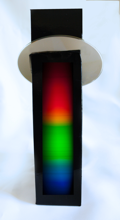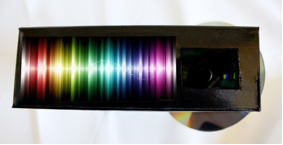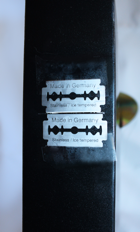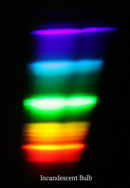by Kathleen Horner
- Published: Monday, April 04 2016 15:30

A cereal box spectroscope with artistic touches applied (Photo A)
 |
 |
| Side view | Viewing window (Photo B) |
 |
 |
| Viewing window with color spectrum (Photo D) | Light slit (Photo C) |
Rainbows fascinate all of us! Scientists were more deeply inspired by the rainbow in a quest to understand the nature of color and light and the relationship of the two. In order to better understand light we must also understand energy. That leads us to this month's AstroCrafts project--Spectroscopy. This activity is probably more project than art and crafts, but you can add some artistic touches to your spectroscope like I did with mine shown in the photos above. I found it quite easy to make this spectroscope by using a CD and a cereal box. In this blog I will cover the basics of the color spectrum, how it works and how to build a spectroscope. I highly recommend that you check out the more detailed links on the scientific information covering spectrometry plus other ways to build a spectroscope for both adults and children located in the resources section at the bottom of this article.
What is a spectroscope?
A spectroscope is a device that separates light into its component colors. The way a spectroscope does this is to make use of diffraction grating. Light reflects through this diffraction grating (for example, a compact disc for this project), and the different colors of the spectrum all reflect a little differently. This is how the colors are separated into the colors of the rainbow. For a more detailed explanation check out the resources list I have provided at the end of this blog.
How is a spectroscope used?
Its many uses are found in the fields of physics, chemistry and biology to determine the composition of different substances. In the field of astronomy it is used to aid astronomers in identifying the temperature, motion and structure of stars, planets and interstellar space. The spectroscope receives and disperses radiant energy or light into a spectrum. After the process of analysis is complete, a record of the spectrum is produced by the spectroscope. This record is known as a spectrograph.

Why use a CD disc?
A CD contains information encoded onto its surface and is stored in the concentric rings to be read by a laser beam when the disk is spinning. The rings can act as a diffraction grating when the light hits them just right.
How does it work?
When light hits the CD it is reflected because of the shiny coating, but is diffracted because of the way it reflects off the bottom of the disc. That is how the white light that enters the slit in the side of the box becomes the spectrum of colors you see when you look through the viewing window. We can thank Sir Isaac Newton for helping us understand the exchange of light and color through his discovery of the color spectrum utilizing his now historical 'crucial experiment' (1662-72). To help you understand how Newton's experiment with light worked, I have included a diagram shown below. The first prism divides a ray of light into its component colors and the colored rays are converted back into white light by the second prism.

Sir Isaac Newton, colorized woodcut from the nineteenth century
Watch what happens when you first peer through the viewing window of your spectroscope once you have pointed it at a light object. I experienced a 'wow' moment when I first peered into my home-made spectroscope! (See Photo D above). You will see a specific line up of colors depending on the source of light. Here's what I found with my spectroscope by pointing it at a incandescent bulb and a computer monitor. The real life view is much sharper than depicted in these photos below but should give you a gist of what you will see.
 |
 |
You can find many sources of light to point your spectroscope towards. Investigate the spectrum of candle light, fluorescent light, sunlight (do not look directly at the Sun. Just point the spectroscope at a white object in sunlight), street lights, moon light, fire, etc. (See resource section for links that explain breakdowns on wavelengths on each light source color spectrum you view).
Here an easy way to create a cereal box spectroscope. Please refer to the photos shown above to give you a visual idea as you read the directions.
MATERIALS
Cereal box
Compact disc
Utility knife or X-Acto knife
Scotch tape, duct tape, package tape
Single edge razor blades or aluminum foil (Blades can be found in any hardware or home improvement store)
Paint, brushes, sponges and other art supplies for designing the outside of the box. I printed out photos of the color spectrum found online and glued them on to the box. Design your own imaginative collage from printed images of color spectrums, rainbows, prisms, etc. online or from magazines.
Directions
* Cut a 1" slit on the side of the top of the cereal box (nutritional information side) centered about 3" down. Make the slit open enough so that light can enter. Place two razor blades with sharp edges facing each other over the slit and tape down. At this point you can also use two neatly cut squares of aluminum foil instead of razor blades. Just make sure the foil edges are cleanly cut. The gap in the slit should be between .4 and 1 mm. No more than 1 mm or the image will become blurry. In the beginning you can apply just a little tape to the blades so you can lift up, reapply the blades and make adjustments to get it just right. (Photo C)
* Cut a slit across the opposite side of the box (top side up) and extend while cutting at an angle of 30 degrees on either side of the box above the horizontal. Here is a protractor printable to help you cut the 30 degree angle: http://www.ossmann.com/protractor/conventional-protractor.pdf. (Photo A)
* Slide a CD shiny side up into this slit. (Photo A)
* 1 " from the side of the top of the box located over the CD, cut a viewing window about 1 1/2" x "1. (Photo B)
Now you can take your spectroscope and point it at any light source and view the wonders of the color spectrum! Check out the resources below to get more ideas and learn more about the color spectrums you are observing from your spectroscope.
Resources
There are quite a few websites with instructions for making a spectroscope in many different ways. I have listed a few other how to methods plus more detailed information on spectrometry while working with your spectroscope below…
* Astronomers Without Borders - Build your own spectroscope http://store.astronomerswithoutborders.org/index.php?main_page=product_info&cPath=14&products_id=32
* https://www.cs.cmu.edu/~zhuxj/astro/html/spectrometer.html
* A video presented by Dr. Andrew Steele will show you how to make a Spectroscope from a CD and cereal box. https://www.youtube.com/watch?v=ZowYVDQDDZ4
*Homemade spectroscope for children--easy and fun! http://buggyandbuddy.com/homemade-spectroscope/
* Another way to build a spectroscope from a cardboard box and detailed information on the color spectrum breakdown: http://sci-toys.com/scitoys/scitoys/light/cd_spectroscope/spectroscope.html
* Teaching light and color to children. Great website packed with multiple resources. http://idahoptv.org/sciencetrek/topics/light_and_color/teachers.cfm
* Newton's Theory of Light from The Star Garden website. http://www.thestargarden.co.uk/Newtons-theory-of-light.html
* The Stanford Solar Center http://solar-center.stanford.edu/activities/cots.html








Comments